Optimizing LoRaWAN Gateway Placement in Urban Environments: A Hybrid PSO-DE Algorithm Validated via HTZ Simulations
Abstract
1. Introduction
Motivation and Contributions
- To develop and implement the GateOpt PSODE algorithm for dynamic and optimal LoRaWAN gateway placement.
- To evaluate the performance impacts of spreading factors SF7 and SF12 on urban network configurations.
- To validate the optimization framework using both HTZ-driven simulations and empirical field data.
- To provide actionable insights and strategic recommendations for effective gateway placements in urban IoT environments.
- By addressing these objectives, this study contributes significantly to the field of urban IoT networking, offering substantial advancements in both theoretical and practical aspects of network design and deployment.
2. Related Work
3. Methodology and System Overview
3.1. Methodology
- Step 1: System Design and Technology Selection: The LoRaWAN configuration in this study operates in the EU868 MHz band, utilizing SF7 for high data rate transmission and SF12 for long-range communication. The hardware selection includes Adeunis Class A/C FTDs for RSSI/SNR measurements, configured with Over-The-Air Activation (OTAA) and 14 dBm transmission power, while Dragino LG308-EC25 gateways with LTE backhaul were strategically placed at five building levels (from the ground to the 9th floor). The experiment was conducted over a 6 h continuous operation, divided into three phases (P1, P2, and P3), in the urban area around Politehnica University of Bucharest, as shown in Figure 2. This location was chosen for its diverse architectural styles and urban infrastructure, including closely packed buildings and open areas, providing a comprehensive environment to assess LoRaWAN performance in dense urban settings.
- Step 2: System Implementation: In the system implementation, the hardware deployment involved positioning gateways vertically to analyze multi-story signal propagation. The network configuration integrated the setup with The Things Network (TTN) for real-time packet monitoring. The experiment assigned specific roles, where the operator manually triggered packet transmissions using the Adeunis FTD, while the monitor validated data reception on TTN.
- Step 3: Data Collection and Preprocessing: In the data collection and preprocessing phase, payload decoding was performed using custom payload formatter in JavaScript, and after that, JSON data was parsed from TTN using Python scripts (PyCharm 2023.2) extracting key metrics, such as RSSI, SNR, GPS, and packet loss. The geodesic distance between devices and gateways was calculated using the geopy library to ensure precise localization. Additionally, K-means clustering was applied, with six clusters for RSSI and seven for SNR, to classify signal quality and analyze network performance more effectively.
- Step 4: Hybrid Optimization (GateOpt PSODE): In the hybrid optimization (GateOpt PSODE) phase, the objective function aimed at minimizing cost, defined as α·norm(RSSI) + β·norm(SNR) + γ·norm(packet loss). The PSO phase focused on global exploration to initialize the weights (α, β, and γ), ensuring an optimal starting point. Following this, the DE phase performed local refinement through mutation and crossover, enhancing the accuracy and efficiency of the gateway placement optimization.
- Step 5: Simulation and Validation: In the simulation and validation phase, HTZ Communications was used to simulate urban propagation, applying the ITU-R 1812-6 model for the ground and 3rd floors and the Cost-Hata 231 model for the top floor. The validation process evaluated key metrics, including standard deviation, average error, and correlation between real-world measurements and simulated data, ensuring the accuracy and reliability of the proposed optimization approach.
3.2. Technology Overview
3.2.1. LoRaWAN Technology
- End devices: These are typically sensors or actuators and may include both. They are generally battery-powered and capable of wireless communication. These devices utilize RF signals modulated through the CSS technique to connect to the network via gateways.
- Gateways: These act as bridges between end devices and the network server. Upon registration with a network server, gateways simply forward the received messages from end devices to the network server and vice versa without performing any computational tasks.
- Network server: This serves as the central management hub of the network, handling all aspects of network operations, including the filtering of duplicate messages and the implementation of adaptive data rate schemes.
- Application server: This manages application-specific data which involves operations such as decryption, data storage, and visualization. This server processes data received from end devices, managing both uplink and downlink data flows as required by the application.
- Class A (Low-Power Bidirectional): This is the default class, where communication is always initiated by the end device. Each uplink transmission is followed by two downlink windows, providing a balanced approach to communication. This setup minimizes power consumption but leads to higher latency [39].
- Class B (Bidirectional with Scheduled Downlink): Its operation is built on a synchronization mechanism between the network (gateway and LoRaWAN Network–Server) and the end devices. It supplements the Class A operation with additional scheduled downlink reception slots (ping slots), which are synchronized with the network via periodic beacons. This class allows for downlink communications at predetermined times, improving the predictability of communications at the cost of slightly increased power consumption [40].
- Class C (Lowest Latency Bidirectional): Class C maintains an almost continuous open receive window, closing only when transmitting. This configuration guarantees the lowest latency to downlink communications, as the network server can send communications at any time, assuming the device’s receiver is open [41].
3.2.2. Hardware Overview
4. Network Architecture Overview
4.1. LoRaWAN Network Architecture
4.2. Data Transmission Workflow
- Temperature: This is decoded from the bytes, with adjustments for a signal, providing critical information for environmental monitoring that can affect device performance and data reliability.
- Trigger Source: This parameter identifies whether data transmission was triggered by movements detected via the accelerometer or manual button presses. It is essential to understand the context in which data is sent, which is vital for applications that react to environmental changes or user interactions.
- GPS Information: By calculating the latitude and longitude from multiple bytes, precise location data is obtained, which is essential for spatial analysis and validating the coverage effectiveness of deployed devices.
- Frame Counters: These counters, which track uplink and downlink frames, are instrumental in identifying packet loss or duplications, which is crucial for maintaining data integrity and efficient network management.
- Battery Level: Decoded from two bytes to reveal the voltage in millivolts, monitoring the battery level is key for predicting device maintenance schedules and ensuring operational longevity.
- RSSI and SNR: These metrics provide data on signal strength and noise ratio, which is fundamental for analyzing communication reliability and optimizing network performance.
5. Computational Techniques for Signal Analysis and Network Optimization
5.1. Distance Calculation
5.2. Clustering Analysis Using K-Means Algorithm
- Step 1: Select the initial k centroids, where k is the number of clusters. In our case, k = 6 for RSSI and k = 7 for SNR, reflecting the data characteristics and allowing for fine distinctions between different signal quality levels.
- Step 2: Assign each data point to the nearest centroid based on Euclidean distance d. The distance between a data point x and a centroid c is computed using Equation (1):where is an individual dimension of the data point , and is the corresponding dimension of the centroid.
- Step 3: Recalculate the centroids by averaging the data points assigned to each cluster. The new centroid c for a cluster S is updated, as in Equation (2):where |S| is the number of data points in cluster S, and the sum is the overall data points x in that cluster.
- Step 4: Repeat the assignment and update the steps until the centroids stabilize and do not change significantly, indicating that the algorithm has converged.
- The resulting clusters for RSSI and SNR were labelled numerically (e.g., Cluster 0, Cluster 1, etc.), with each cluster representing a different range of signal values.
5.3. The Particle Swarm Optimization (PSO) Algorithm
5.4. Differential Evolution (DE) Algorithm
5.5. Hybrid PSO-DE (GateOpt PSODE)
| Algorithm 1: Hybrid Particle Swarm Optimization + Differential Evolution (PSO + DE) | ||
| Input: | ||
| rssi: Array of RSSI values for each floor snr: Array of SNR values for each floor packet_loss: Array of packet loss values for each floor label: Descriptor (e.g., ‘SF12’ and ‘SF7’) | ||
| Output: | ||
| Optimized weights (alpha, beta, and gamma) Optimized scores for each floor | ||
| 1 | Normalize the input data: | |
| 2 | Optimize using PSO: | |
| best_weights_pso = optimize_with_pso) Function optimize_with_pso(norm_rssi, norm_snr, norm_packet_loss): Initialize PSO with specific parameters For each iteration: Update positions and velocities of particles Evaluate cost function: Update particle velocities and positions based on personal and global best Return best weights ) from PSO | ||
| 3 | Fine-tune using DE: | |
| best_weights_de = optimize_with_de(best_weights_pso, ) Function optimize_with_de(best_weights_pso, ): Set bounds for alpha, beta, and gamma Initialize population around best_weights_pso For each generation: Perform mutation, crossover, and selection based on the DE cost function evaluation Return best weights found by DE | ||
| 4 | Calculate and normalize final scores: | |
| final_scores = calculate_scores(floors, rssi, snr, , best_weights_de) Function calculate_scores(floors, rssi, snr, , best_weights): For each floor: for the floor Return dictionary or dataframe containing floors and their corresponding optimized scores | ||
| 5 | Display results: | |
| Output the best_weights_de and final_scores Visualize scores on a bar chart with a color map reflecting the score intensity | ||
| End Algorithm | ||
5.6. HTZ Simulation Parameters
6. Experimental Results and Analysis
6.1. SF7 and SF12 Comparative Analysis
6.1.1. Packet Loss Evaluation
- S is the receiver sensitivity (dBm);
- BW is the bandwidth (KHz);
- NF is the noise figure (dB);
- SNRmin is the minimum required Signal-To-Noise Ratio for a given spreading factor.
6.1.2. RSSI Analysis with Clustering
6.1.3. SNR Analysis with Clustering
6.1.4. GateOpt PSODE Results—Single Gateway
6.2. Multi-Gateway Placement Evaluation
6.2.1. Packet Loss Evaluation Across Scenarios
6.2.2. GateOpt PSODE Optimization Results
6.3. HTZ Simulation Validation
7. Conclusions
Author Contributions
Funding
Institutional Review Board Statement
Informed Consent Statement
Data Availability Statement
Acknowledgments
Conflicts of Interest
Abbreviations
| ADR | Adaptive data rate |
| CSS | Chirp Spread Spectrum |
| DE | Differential Evolution |
| EIRP | Equivalent Isotropically Radiated Power |
| FTD | Field Test Device |
| GBEST | Global Best Position (in PSO) |
| GPS | Global Positioning System |
| GateOpt PSODE | Gateway Optimization Particle Swarm Optimization + Differential Evolution (hybrid algorithm) |
| HTZ | HTZ Communications (simulation software) |
| IoT | Internet of Things |
| ISM | Industrial, Scientific, and Medical (band) |
| LPWAN | Low-Power Wide-Area Network |
| MAC | Medium Access Control |
| OTAA | Over-The-Air Activation |
| PHY | Physical layer |
| PSO | Particle Swarm Optimization |
| PDR | Packet Delivery Ratio (implied in context) |
| RF | Radio Frequency |
| RSSI | Received Signal Strength Indicator |
| SF | Spreading factor |
| SNR | Signal-to-Noise Ratio |
| TTN | The Things Network |
| UAV | Unmanned Aerial Vehicle |
| WSN | Wireless Sensor Network |
References
- Apriantoro, R.; Suharjono, A.; Kurnianingsih, K.; Enriko, I.K.A. Investigation of Coverage and Signal Quality of LoRaWAN Network in Urban Area. In Proceedings of the 2020 International Conference on Computer Engineering, Network, and Intelligent Multimedia (CENIM), Surabaya, Indonesia, 17 November 2020; IEEE: Piscataway, NJ, USA, 2020; pp. 326–331. [Google Scholar]
- Majid, M.; Habib, S.; Javed, A.R.; Rizwan, M.; Srivastava, G.; Gadekallu, T.R.; Lin, J.C.-W. Applications of Wireless Sensor Networks and Internet of Things Frameworks in the Industry Revolution 4.0: A Systematic Literature Review. Sensors 2022, 22, 2087. [Google Scholar] [CrossRef] [PubMed]
- Narasimha Swamy, S.; Kota, S.R. An Empirical Study on System Level Aspects of Internet of Things (IoT). IEEE Access 2020, 8, 188082–188134. [Google Scholar] [CrossRef]
- Maini, J.; Rani, S. Introduction to IoT and WSN. In WSN and IoT; CRC Press: Boca Raton, FL, USA, 2024; pp. 1–34. ISBN 9781003437079. [Google Scholar]
- Al-Sammak, K.A.; Al-Gburi, S.H.; Marghescu, C.; Drăgulinescu, A.M.; Suciu, G.; Abdulqader, A.G. A Comprehensive Assessment of LoRaWAN and NB-IoT Performance Metrics under Varied Payload Data Sizes. In Proceedings of the 2024 16th International Conference on Electronics, Computers and Artificial Intelligence (ECAI), Iasi, Romania, 27 June 2024; IEEE: Piscataway, NJ, USA, 2024; pp. 1–5. [Google Scholar]
- Ogbodo, E.U.; Abu-Mahfouz, A.; Kurien, A. A Survey on 5G and LPWAN-IoT for Improved Smart Cities and Remote Area Applications: From the Aspect of Architecture and Security. Sensors 2022, 22, 6313. [Google Scholar] [CrossRef] [PubMed]
- Janssen, T.; Koppert, A.; Berkvens, R.; Weyn, M. A Survey on IoT Positioning Leveraging LPWAN, GNSS, and LEO-PNT. IEEE Internet Things J. 2023, 10, 11135–11159. [Google Scholar] [CrossRef]
- Ouaissa, M.; Ouaissa, M.; Khan, I.U.; Boulouard, Z.; Rashid, J. Low-Power Wide Area Network for Large Scale Internet of Things: Architectures, Communication Protocols and Recent Trends; Ouaissa, M., Khan, I.U., Boulouard, Z., Rashid, J., Eds.; Taylor & Francis: London, UK, 2024; ISBN 9781040005774. [Google Scholar]
- Al-Sammak, K.; Al-Gburi, S.; Marghescu, I.; Drãgulinescu, A.M.C.; Marghescu, C.; Martian, A.; Al-Sammak, N.A.H.; Suciu, G.; Alheeti, K. Optimizing IoT Energy Efficiency: Real-Time Adaptive Algorithms for Smart Meters with LoRaWAN and NB-IoT. Energies 2025, 18, 987. [Google Scholar] [CrossRef]
- Kwasme, H.; Ekin, S. RSSI-Based Localization Using LoRaWAN Technology. IEEE Access 2019, 7, 99856–99866. [Google Scholar] [CrossRef]
- Jeftenic, N.; Simic, M.; Stamenkovic, Z. Impact of Environmental Parameters on SNR and RSS in LoRaWAN. In Proceedings of the 2020 International Conference on Electrical, Communication, and Computer Engineering (ICECCE), Istanbul, Turkey, 12–13 June 2020; IEEE: Piscataway, NJ, USA, 2020. [Google Scholar]
- Al-Sammak, K.; AL-Gburi, S.; Marghescu, I. Communications Systems in Smart Metering: A Concise Systematic Literature Review. In Proceedings of the 2022 14th International Conference on Communications (COMM), Bucharest, Romania, 16 June 2022; IEEE: Piscataway, NJ, USA, 2022; pp. 1–9. [Google Scholar]
- Yatagan, T.; Oktug, S. Smart Spreading Factor Assignment for LoRaWANs. In Proceedings of the 2019 IEEE Symposium on Computers and Communications (ISCC), Barcelona, Spain, 29 June–3 July 2019; IEEE: Piscataway, NJ, USA, 2019. [Google Scholar]
- Turcinovic, F.; Vukovic, J.; Bozo, S.; Sisul, G. Analysis of LoRa Parameters in Real-World Communication. In Proceedings of the 2020 International Symposium ELMAR, Zadar, Croatia, 14–15 September 2020; IEEE: Piscataway, NJ, USA, 2020. [Google Scholar]
- Kamal, A.; Muhammad, M.; Mansoor Alam, A.A.B.; Mohd Su’ud, M. Requirements, Deployments, Challenges LoRa Technology: Survey. Comput. Intell. Neurosci. 2023, 2023, 5183062. [Google Scholar] [CrossRef]
- Savithi, C.; Kaewta, C. Multi-Objective Optimization Gateway Location Selection Long-Range Wide Area Networks: Tradeoff Analysis between System Costs Bitrate Maximization. J. Sens. Actuator Netw. 2024, 13, 3. [Google Scholar] [CrossRef]
- Citoni, B.; Ansari, S.; Abbasi, Q.H.; Imran, M.A.; Hussain, S. Impact of Inter-Gateway Distance on LoRaWAN Performance. Electronics 2021, 10, 2197. [Google Scholar] [CrossRef]
- Saban, M.; Aghzout, O.; Medus, L.D.; Rosado, A. Experimental Analysis of IoT Networks Based on LoRa/LoRaWAN under Indoor and Outdoor Environments: Performance and Limitations. IFAC-Pap. 2021, 54, 159–164. [Google Scholar] [CrossRef]
- Mikhaylov, K.; Stusek, M.; Masek, P.; Fujdiak, R.; Mozny, R.; Andreev, S.; Hosek, J. On the Performance of Multi-Gateway LoRaWAN Deployments: An Experimental Study. In Proceedings of the 2020 IEEE Wireless Communications and Networking Conference (WCNC), Seoul, Republic of Korea, 25–28 May 2020; IEEE: Piscataway, NJ, USA, 2020. [Google Scholar]
- Svertoka, E.; Rusu-Casandra, A.; Burget, R.; Marghescu, I.; Hosek, J.; Ometov, A. LoRaWAN: Lost for Localization? IEEE Sens. J. 2022, 22, 23307–23319. [Google Scholar] [CrossRef]
- Dawaliby, S.; Bradai, A.; Pousset, Y. Joint Slice-Based Spreading Factor and Transmission Power Optimization in LoRa Smart City Networks. Internet Things 2021, 14, 100121. [Google Scholar] [CrossRef]
- Svertoka, E.; Rusu-Casandra, A.; Burget, R.; Nurmi, J.; Ometov, A. K-NN Empowered LoRaWAN Localization for Surface and Underground Scenarios: Work-in-Progress Report. 2024. Available online: https://researchportal.tuni.fi/en/publications/k-nn-empowered-lorawan-localization-for-surface-and-underground-s (accessed on 21 May 2025).
- Cruz, H.A.O.; Ferreira, S.C.B.; Araújo, J.P.L.; Barros, F.J.B.; Farias, F.S.; Neto, M.C.A.; Tostes, M.E.L.; Nascimento, A.A.; Cavalcante, G.P.S. Methodology for LoRa Gateway Placement Based on Bio-Inspired Algorithmsfor a Smart Campus in Wooded Area. Sensors 2022, 22, 6492. [Google Scholar] [CrossRef] [PubMed]
- Abubakar, A.K.; Shore, T.; Sastry, N. Constrained Machine Learning for LoRa Gateway Location Optimisation. In Proceedings of the 17th Asian Internet Engineering Conference, Hiroshima, Japan, 19 December 2022; ACM: New York, NY, USA, 2022. [Google Scholar]
- Ousat, B.; Ghaderi, M. LoRa Network Planning: Gateway Placement and Device Configuration. In Proceedings of the 2019 IEEE International Congress on Internet of Things (ICIOT), Milan, Italy, 8–13 July 2019; IEEE: Piscataway, NJ, USA, 2019. [Google Scholar]
- Mendes, B.; Correia, N.; Passos, D. On the Optimization of LoRaWAN Gateway Placement in Wide Area Monitoring Systems. In Internet of Things. IoT Through a Multi-Disciplinary Perspective; IFIP Advances in Information and Communication Technology; Springer International Publishing: Cham, Switzerland, 2022; pp. 41–51. ISBN 9783031188718. [Google Scholar]
- Rezazadeh, A.; Soorki, M.N.; Kavian, Y.S.; Ranjbaran, S.; Nitti, M. Gateway Planning for the Long-Range Wireless Networks in Smart Cities. In Proceedings of the 2024 IEEE 35th International Symposium on Personal, Indoor and Mobile Radio Communications (PIMRC), Valencia, Spain, 2 September 2024; IEEE: Piscataway, NJ, USA, 2024; pp. 1–7. [Google Scholar]
- Nyirenda, C.N. On the Efficacy of Particle Swarm Optimization for Gateway Placement in LoRaWAN Networks. In Optimisation Algorithms and Swarm Intelligence; IntechOpen: London, UK, 2022; ISBN 9781839686658. [Google Scholar]
- Saheb, T.; Mellal, M.A. Improvement of System Reliability in a Natural Gas Processing Facility by PSO and DE. Int. J. Interact. Des. Manuf. (IJIDeM) 2024, 18, 167–176. [Google Scholar] [CrossRef]
- Hosseinzadeh, S.; Göktürkler, G.; Turan-Karaoğlan, S. Inversion of Self-Potential Data by a Hybrid DE/PSO Algorithm. Acta Geod. Geophys. 2023, 58, 241–272. [Google Scholar] [CrossRef]
- Wang, C.; Xu, M.; Zhang, Q.; Feng, J.; Jiang, R.; Wei, Y.; Liu, Y. Parameters Identification of Thevenin Model for Lithium-Ion Batteries Using Self-Adaptive Particle Swarm Optimization Differential Evolution Algorithm to Estimate State of Charge. J. Energy Storage 2021, 44, 103244. [Google Scholar] [CrossRef]
- Mohammadi, B.; Guan, Y.; Moazenzadeh, R.; Safari, M.J.S. Implementation of Hybrid Particle Swarm Optimization-Differential Evolution Algorithms Coupled with Multi-Layer Perceptron for Suspended Sediment Load Estimation. Catena 2021, 198, 105024. [Google Scholar] [CrossRef]
- Iweh, C.D.; Akupan, E.R. Control and Optimization of a Hybrid Solar PV—Hydro Power System for off-Grid Applications Using Particle Swarm Optimization (PSO) and Differential Evolution (DE). Energy Rep. 2023, 10, 4253–4270. [Google Scholar] [CrossRef]
- Huang, C.; Zhou, X.; Ran, X.; Wang, J.; Chen, H.; Deng, W. Adaptive Cylinder Vector Particle Swarm Optimization with Differential Evolution for UAV Path Planning. Eng. Appl. Artif. Intell. 2023, 121, 105942. [Google Scholar] [CrossRef]
- Boks, R.; Wang, H.; Bäck, T. A Modular Hybridization of Particle Swarm Optimization and Differential Evolution. arXiv 2020, arXiv:2006.11886. [Google Scholar]
- Almuhaya, M.A.M.; Jabbar, W.A.; Sulaiman, N.; Abdulmalek, S. A Survey on LoRaWAN Technology: Recent Trends, Opportunities, Simulation Tools and Future Directions. Electronics 2022, 11, 164. [Google Scholar] [CrossRef]
- Osorio, A.; Calle, M.; Soto, J.D.; Candelo-Becerra, J.E. Routing in LoRaWAN: Overview and Challenges. IEEE Commun. Mag. 2020, 58, 72–76. [Google Scholar] [CrossRef]
- TS001-1.0.4 LoRaWAN® L2 1.0.4 Specification. Available online: https://resources.lora-alliance.org/technical-specifications/ts001-1-0-4-lorawan-l2-1-0-4-specification (accessed on 29 December 2024).
- Obiri, N.M.; Van Laerhoven, K. A Survey of LoRaWAN-Integrated Wearable Sensor Networks for Human Activity Recognition: Applications, Challenges and Possible Solutions. IEEE Open J. Commun. Soc. 2024, 5, 6713–6735. [Google Scholar] [CrossRef]
- Elbsir, H.E.; Kassab, M.; Bhiri, S.; Bedoui, M.H. Evaluation of LoRaWAN Class B Performances and Its Optimization for Better Support of Actuators. Comput. Commun. 2023, 198, 128–139. [Google Scholar] [CrossRef]
- Leonardi, L.; Lo Bello, L.L.; Patti, G.; Pirri, A.; Pirri, M. Combined Use of LoRaWAN Medium Access Control Protocols for IoT Applications. Appl. Sci. 2023, 13, 2341. [Google Scholar] [CrossRef]
- Fontana, C. FTD: Network Tester. Available online: https://www.adeunis.com/en/produit/ftd-network-tester/ (accessed on 19 March 2025).
- Dragino Download Server./Downloads/LoRa_gateway/LG308-LG301/. Available online: https://www.dragino.com/downloads/index.php?dir=LoRa_Gateway/LG308-LG301/ (accessed on 19 March 2025).
- Alkhayyal, M.; Mostafa, A.M. Recent Developments in AI and ML for IoT: A Systematic Literature Review on LoRaWAN Energy Efficiency and Performance Optimization. Sensors 2024, 24, 4482. [Google Scholar] [CrossRef]
- Gad, A.G. Particle Swarm Optimization Algorithm and Its Applications: A Systematic Review. Arch. Comput. Methods Eng. 2022, 29, 2531–2561. [Google Scholar] [CrossRef]
- Storn, R.; Price, K. Differential Evolution—A Simple and Efficient Heuristic for Global Optimization over Continuous Spaces. J. Glob. Optim. 1997, 11, 341–359. [Google Scholar] [CrossRef]
- Ahmad, M.F.; Isa, N.A.M.; Lim, W.H.; Ang, K.M. Differential Evolution: A Recent Review Based on State-of-the-Art Works. Alex. Eng. J. 2022, 61, 3831–3872. [Google Scholar] [CrossRef]
- Bilal; Pant, M.; Zaheer, H.; Garcia-Hernandez, L.; Abraham, A. Differential Evolution: A Review of More than Two Decades of Research. Eng. Appl. Artif. Intell. 2020, 90, 103479. [Google Scholar] [CrossRef]
- Wang, D.; Tan, D.; Liu, L. Particle Swarm Optimization Algorithm: An Overview. Soft Comput. 2018, 22, 387–408. [Google Scholar] [CrossRef]
- Price, K.; Storn, R.M.; Lampinen, J.A. Differential Evolution: A Practical Approach to Global Optimization; Natural Computing; Springer: Berlin/Heidelberg, Germany, 2005; ISBN 9783540313069. [Google Scholar]
- HTZ Communications. Available online: https://atdi.com/products-and-solutions/htz-communications/ (accessed on 19 March 2025).

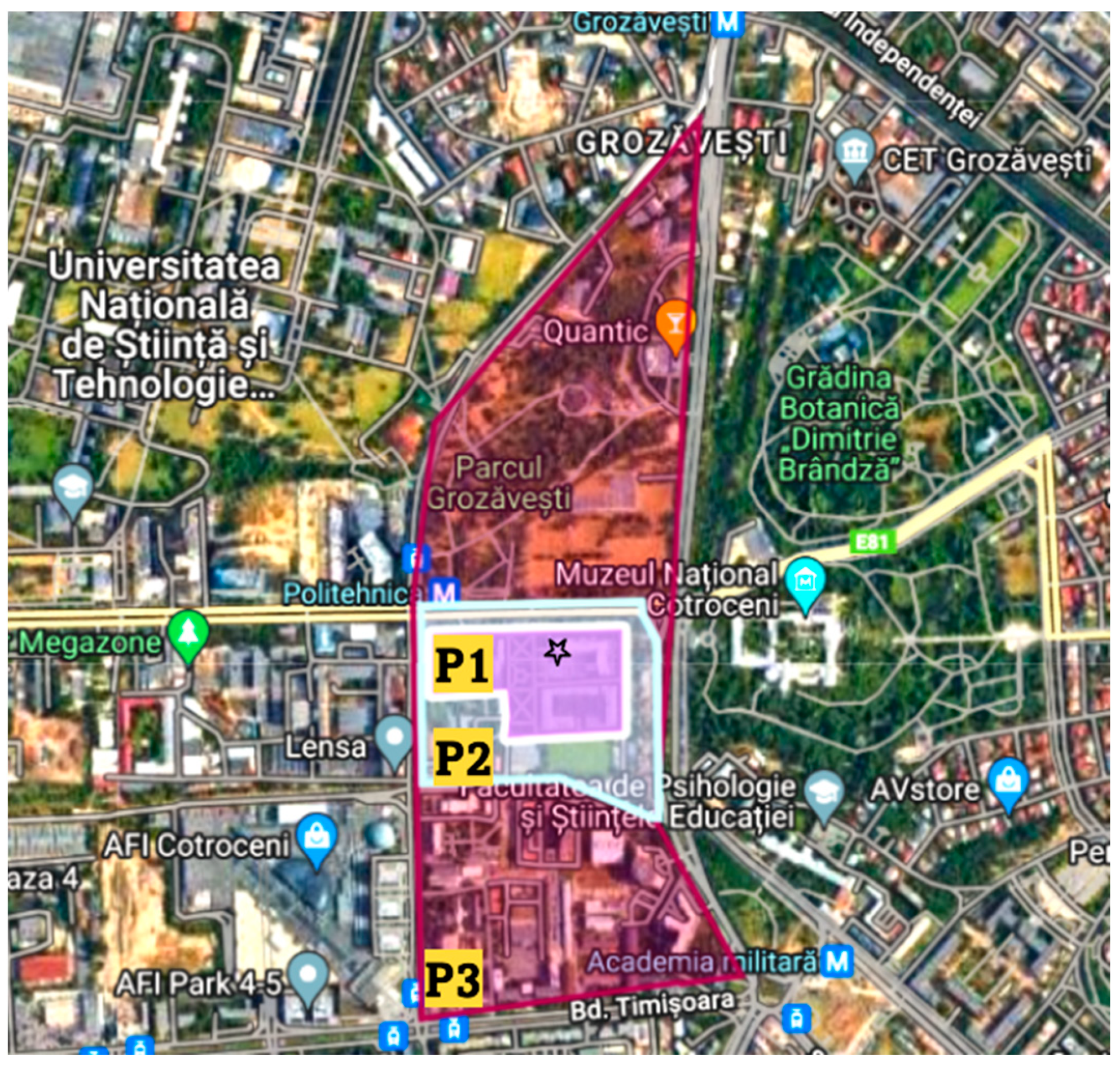

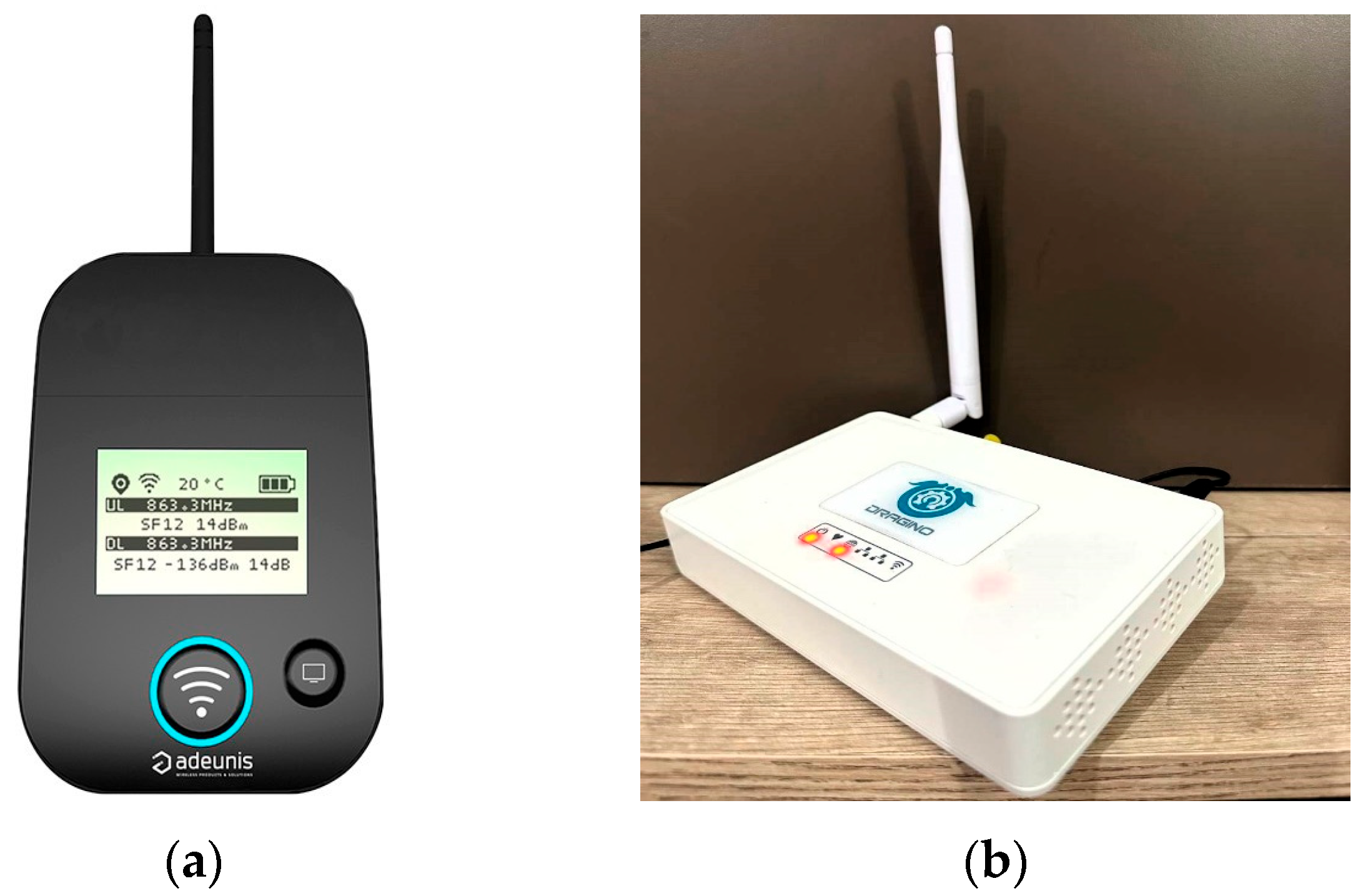
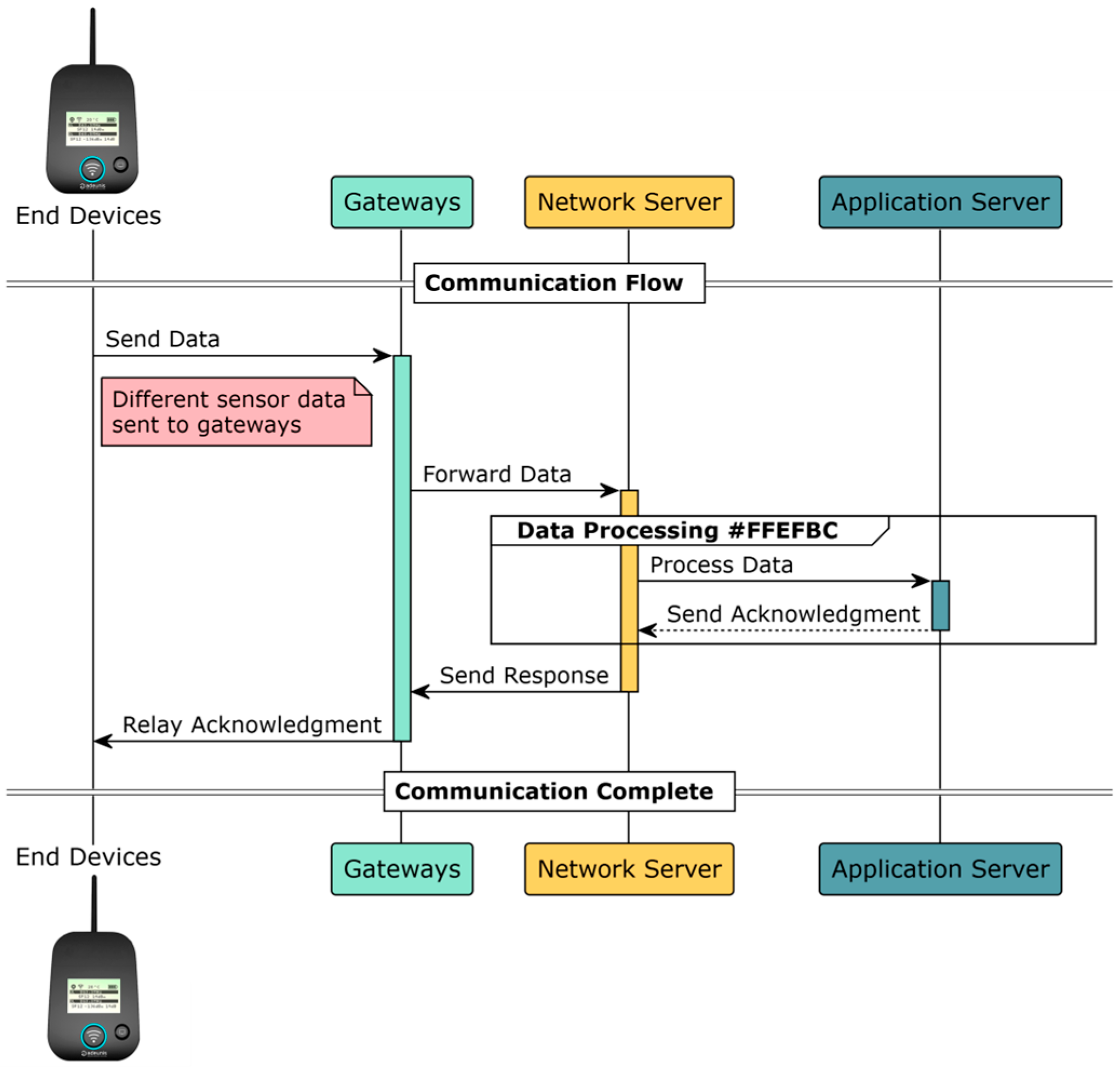

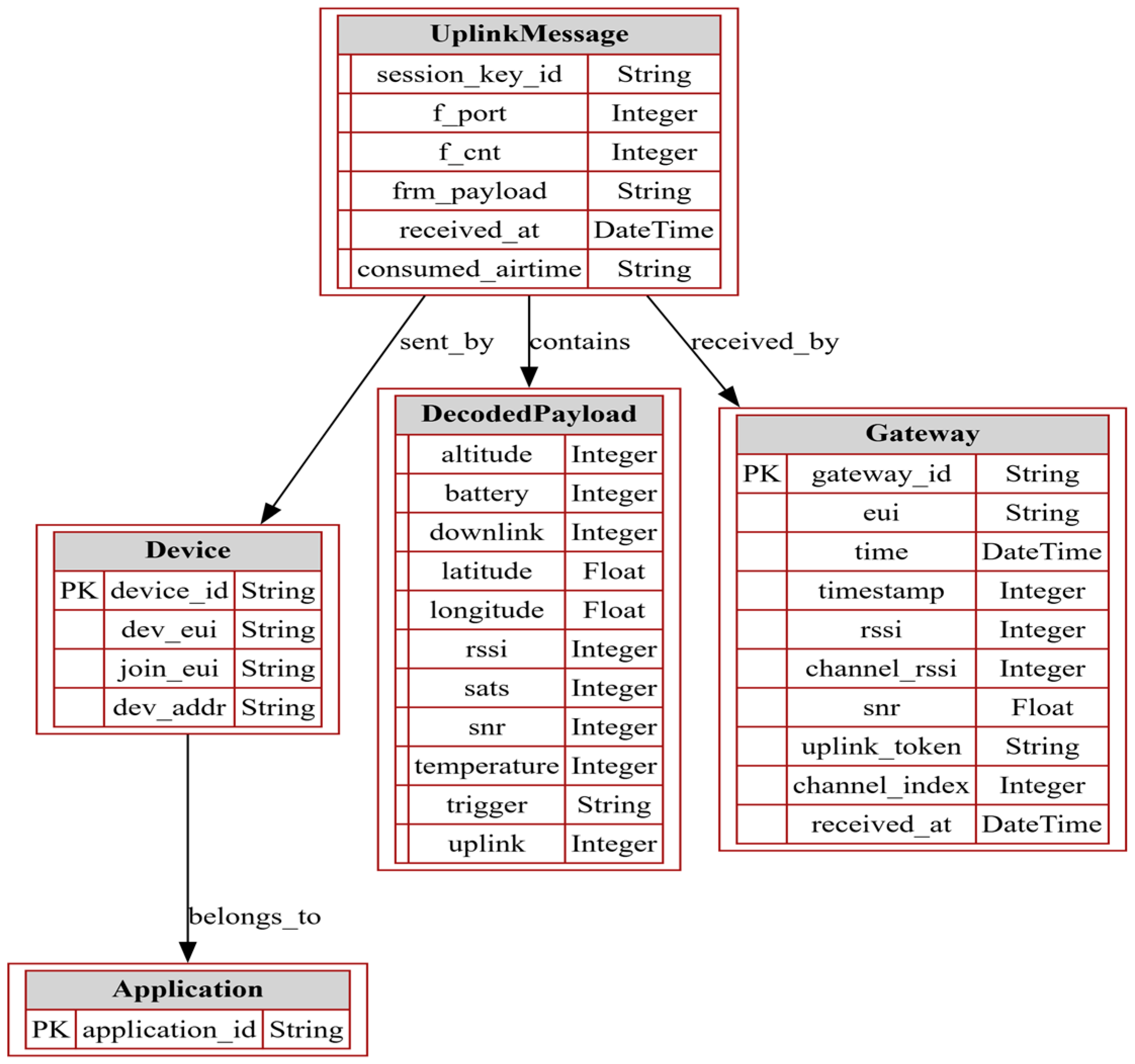
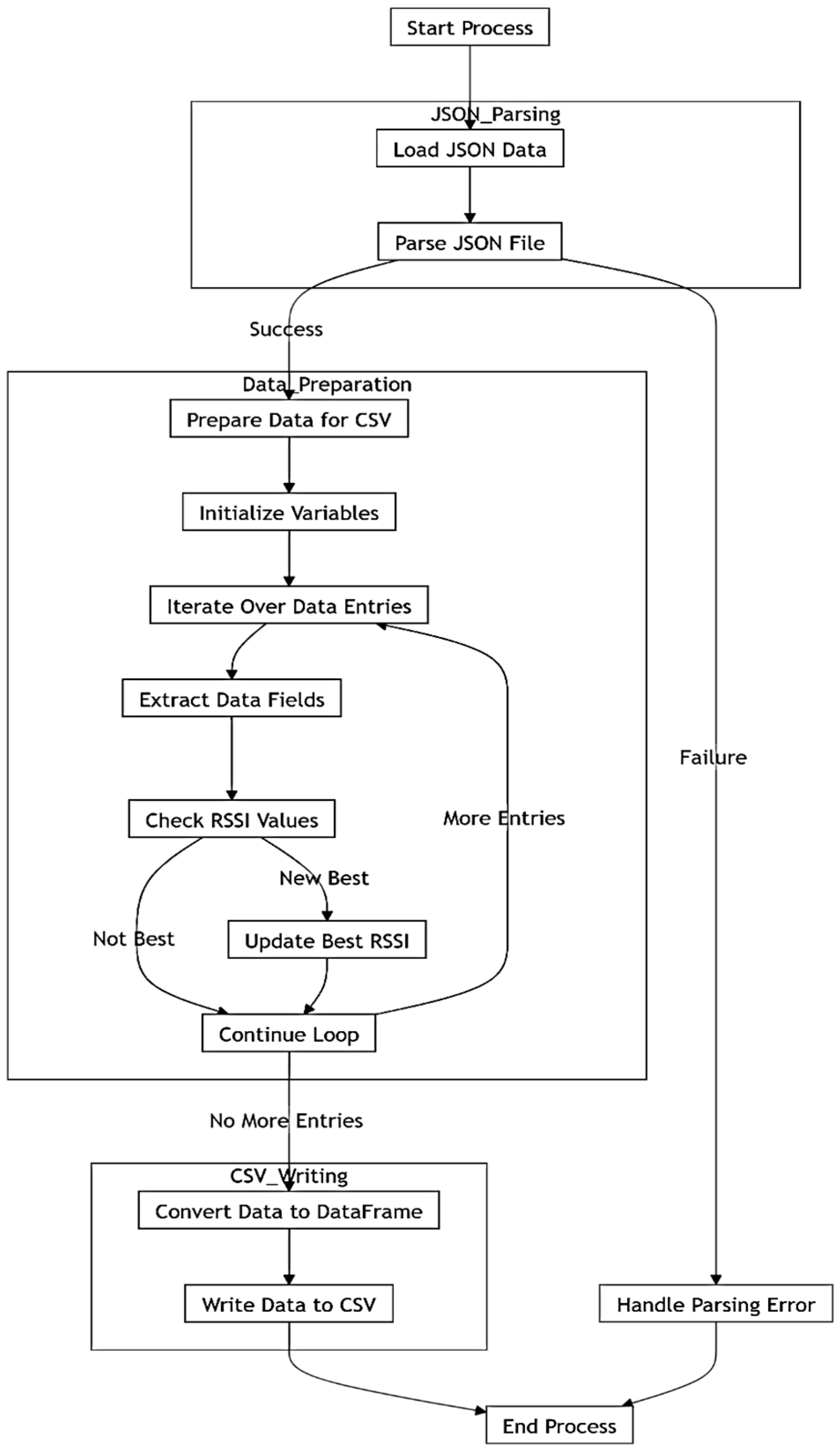
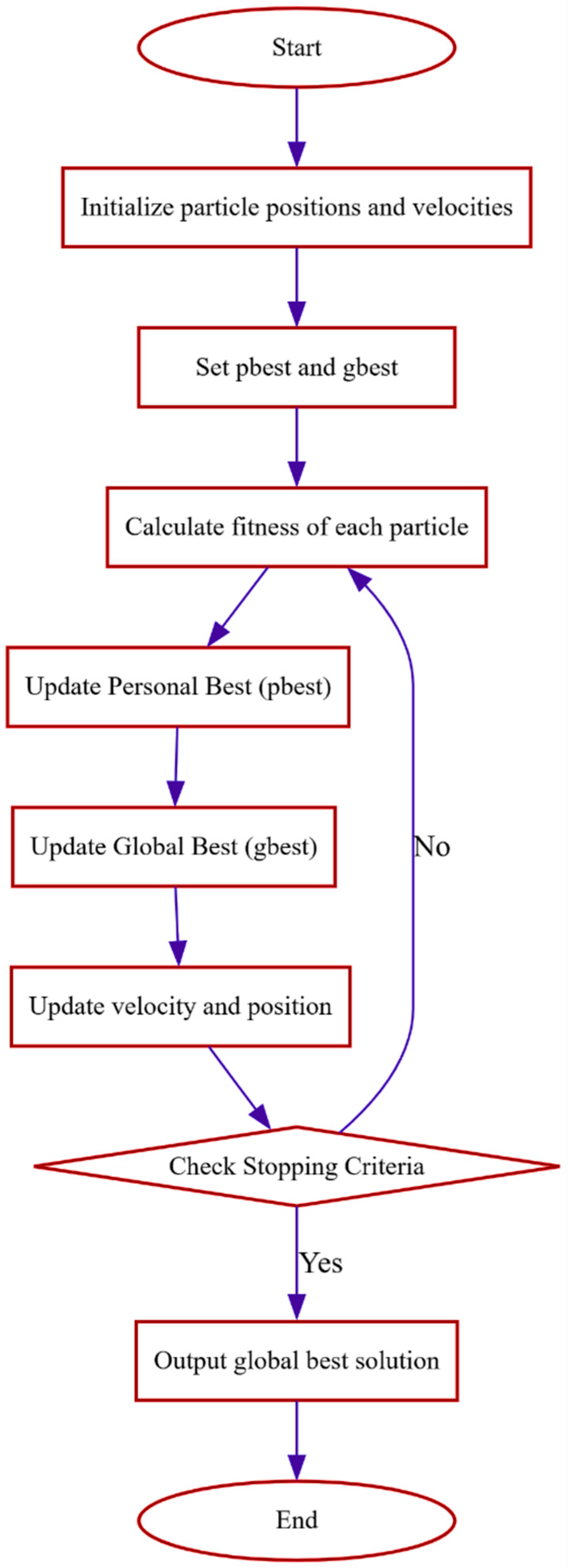


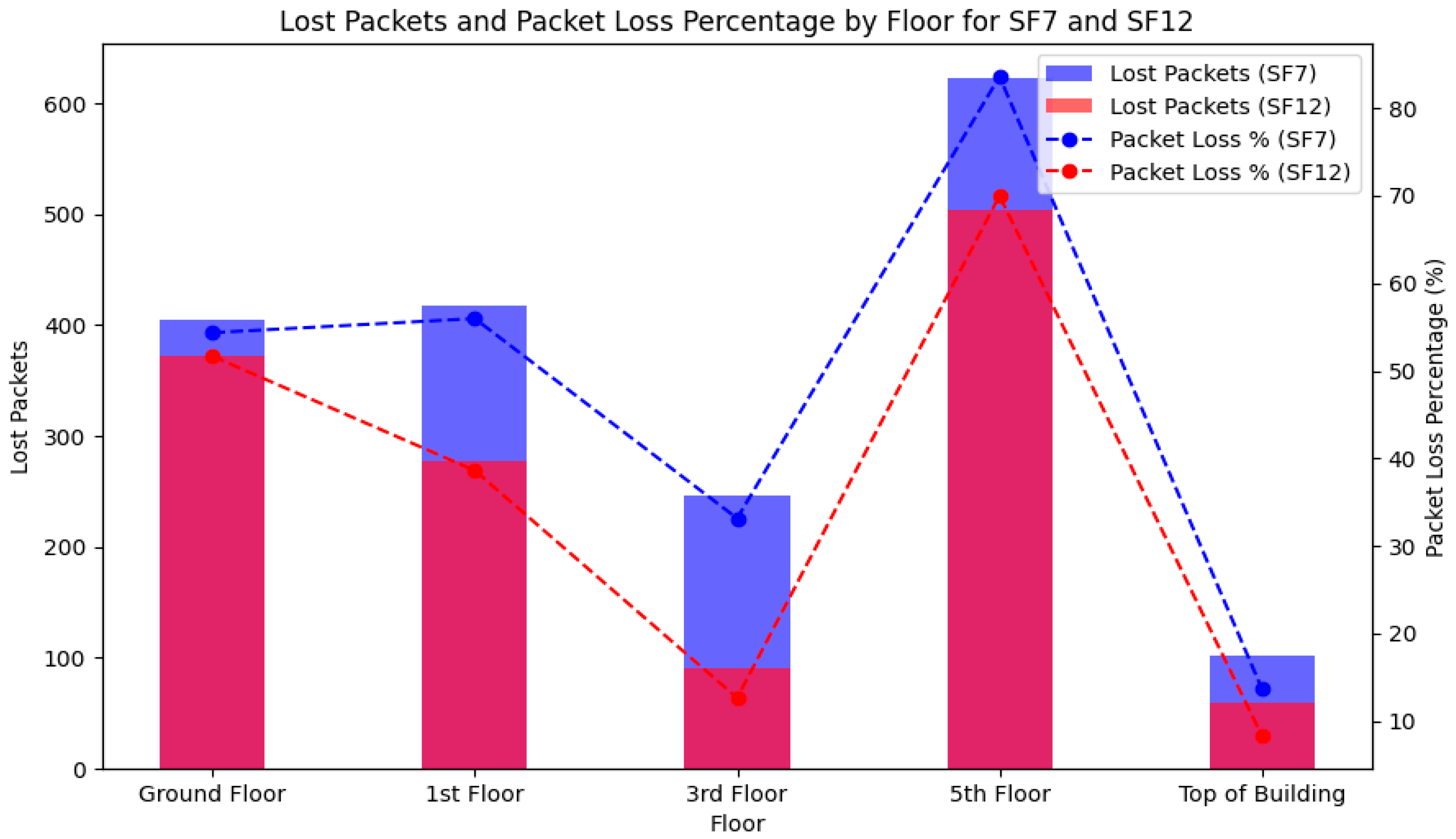

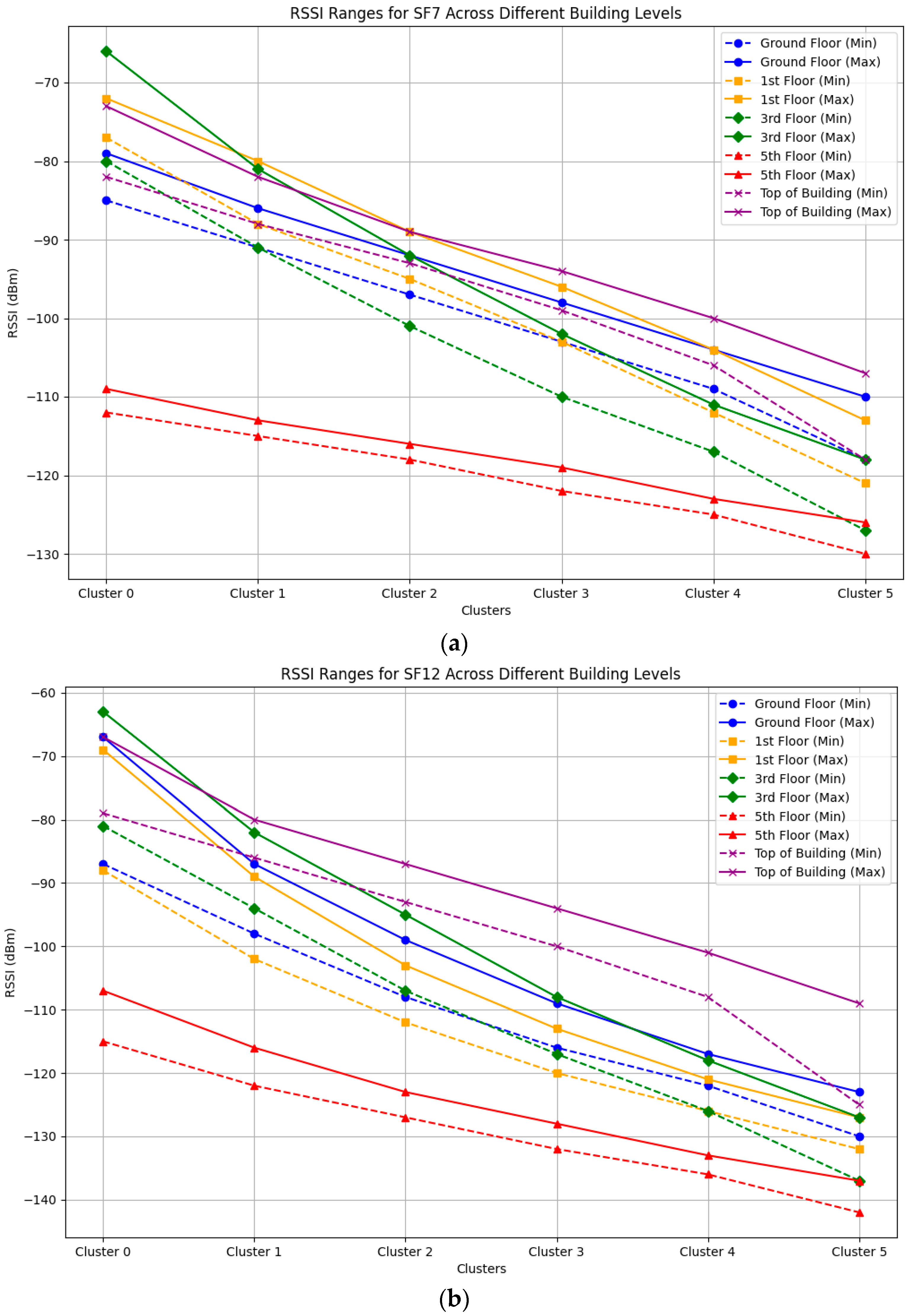

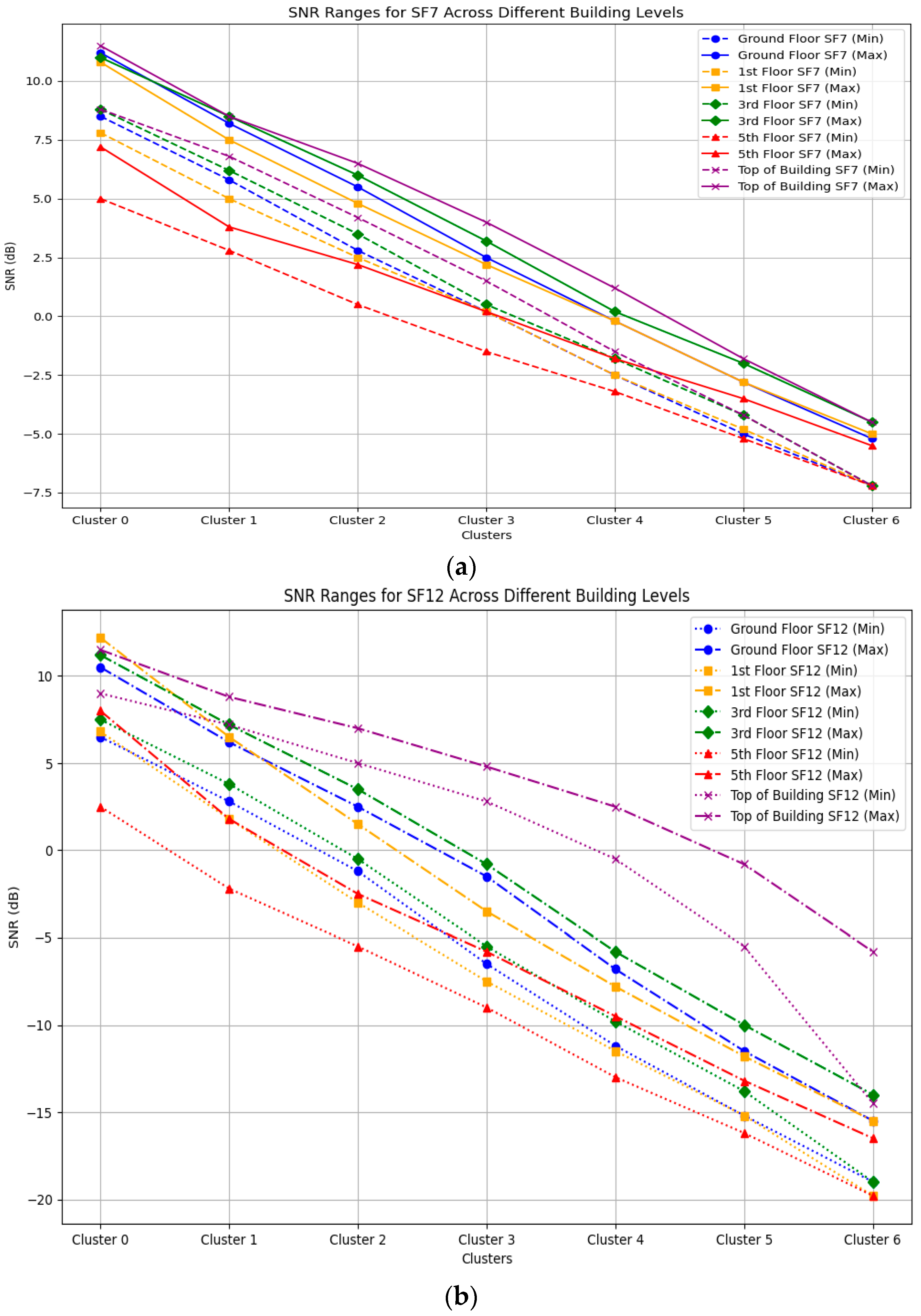

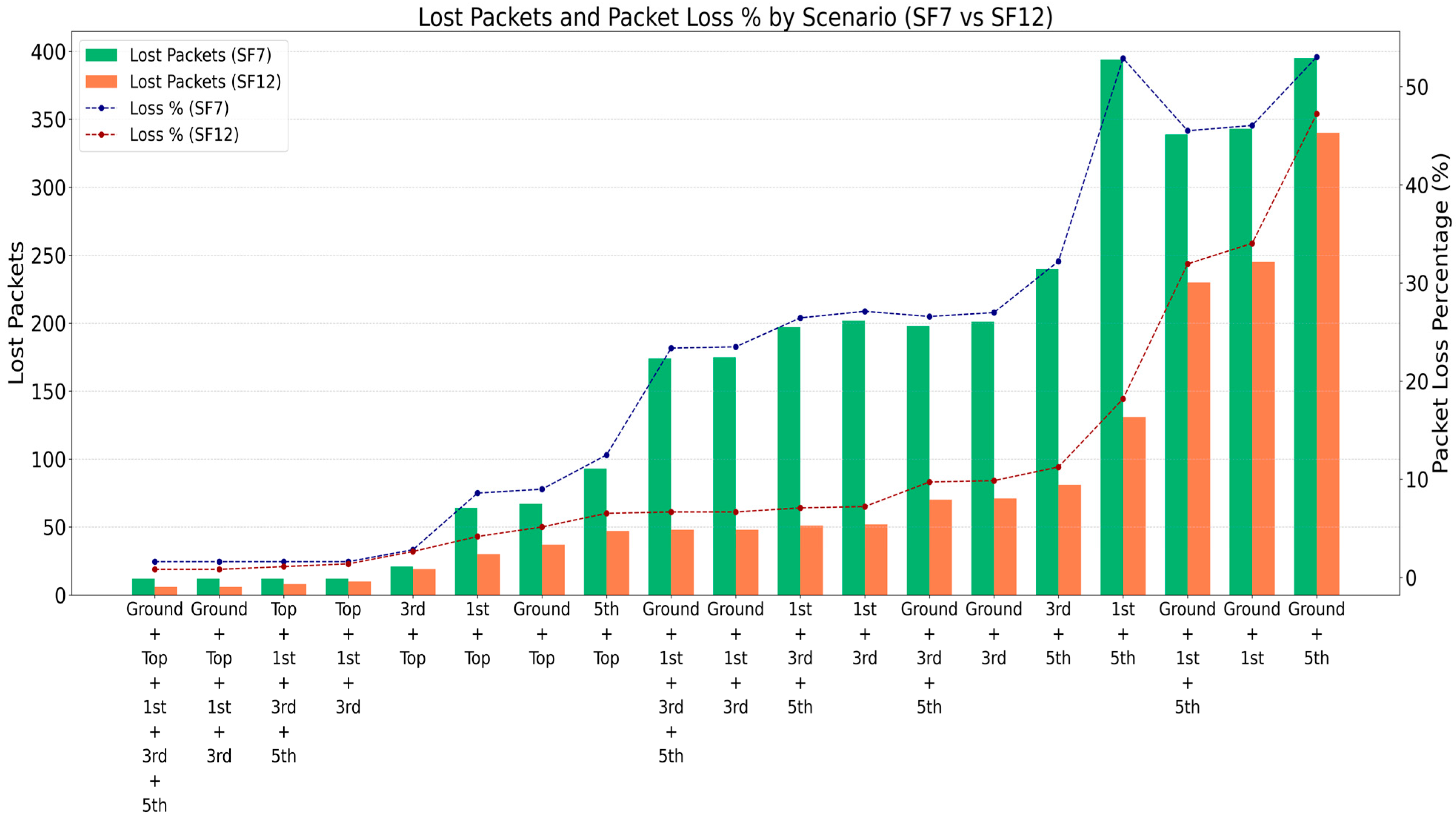



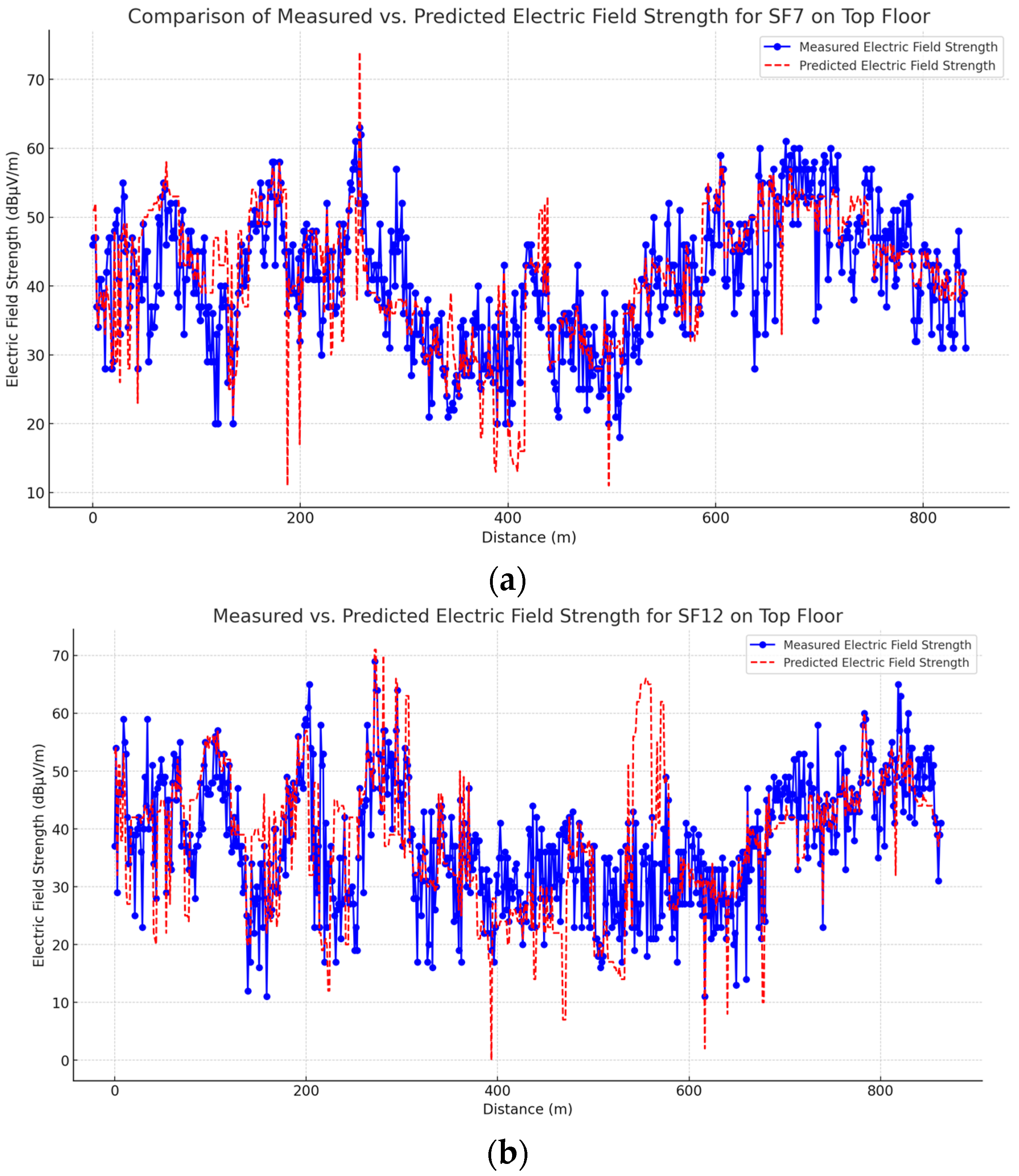

| Aspect | Present Works | Comparison of GateOpt PSODE | Aspect |
|---|---|---|---|
| Application diversity | Reliability optimization [29], parameter estimation [30], SOC estimation [31], and SSL modeling [32]. | While other algorithms target diverse domains (engineering, hydrology, and battery modeling), GateOpt PSODE focuses on optimizing LoRaWAN gateway placement for communication network performance, addressing a unique and underexplored domain. | Application diversity |
| Multi-objective handling | AI-based PSO and DE [33] balance LCOE and LPSP for renewable energy systems and ACVDEPSO [34] for UAVs. | GateOpt PSODE similarly balances RSSI, SNR, and packet loss but applies this balance to communication network metrics, ensuring robust performance in LPWAN environments, a specialized multi-objective approach. | Multi-objective handling |
| Scalability | Modular hybridization [35] demonstrates scalability with 800 hybrid variants. | GateOpt PSODE leverages scalability by applying k-means clustering for preprocessing, enabling it to efficiently manage clusters of RSSI and SNR data across multiple gateways in large network setups. | Scalability |
| Algorithm design | Algorithms like SaPSODE [31] and MLP-PSODE [32] integrate advanced features like self-adaptive mutation. | GateOpt PSODE integrates advanced hybrid features, combining PSO and DE with a clustering approach, providing a unique mix of exploration and exploitation tailored to network deployment problems. | Algorithm design |
| Performance metrics | Improved performance shown for SSL accuracy [32], reduced LCOE [33], and reliable redundancy [29]. | GateOpt PSODE achieves significant performance improvement in network metrics such as RSSI, SNR, and packet loss, ensuring optimized gateway placement and superior coverage compared to traditional placement strategies. | Performance metrics |
| Field-specific benefits | UAV navigation in 3D [34], renewable energy optimization [33], and hydrological modeling [32]. | GateOpt PSODE introduces field-specific advantages by addressing real-world LPWAN challenges, like interference, multi-gateway placement, and maintaining connectivity in dynamic building environments, offering a unique solution tailored to LoRaWAN. | Field-specific benefits |
| Application diversity | Reliability optimization [29], parameter estimation [30], SOC estimation [31], and SSL modeling [32]. | While other algorithms target diverse domains (engineering, hydrology, and battery modeling), GateOpt PSODE focuses on optimizing LoRaWAN gateway placement for communication network performance, addressing a unique and underexplored domain. | Application diversity |
| Specification | Details |
|---|---|
| Spreading factors | SF7 and SF12 |
| Frequency band | European ISM band (863–870 MHz) |
| LoRaWAN-supported regions | EU863-870 (experiment conducted in Romania) |
| Wireless security | AES-128 data encryption (LoRaWAN only) |
| LoRaWAN class | Class A |
| LoRaWAN features | OTAA (Over-The-Air Activation) |
| Adaptive data rate (ADR) | Disabled |
| RF transmission power | 14 dBm (25 mW) |
| Sensitivity | −140 dBm LoRaWAN EU868 @SF12 |
| Supported protocols | LoRaWAN |
| GPS support | Latitude/longitude coordinates in degrees, minutes, and seconds |
| Range | Up to 15 km in rural areas and 2 to 5 km in urban areas |
| Specification | Details |
|---|---|
| LoRaWAN compatibility | Multi-channel support for EU868 (863–870 MHz) |
| Backhaul | EC25 LTE module for cellular connectivity |
| Sensitivity | Up to −142.5 dBm with SX1250 Tx/Rx front-end |
| Signal rejection | 70 dB CW interferer rejection at 1 MHz offset |
| Demodulation capability | 8 × SF5-SF12, 125/250/500 kHz LoRa, and (G)FSK demodulator |
| Parallel demodulation paths | 10 programmable parallel paths |
| Dynamic data rate (DDR) | Supports DDR adaptation for efficient transmission |
| Antenna diversity | True antenna diversity for reliable reception |
| Placement in experiment | Ground floor, 1st floor, 3rd floor, 5th floor, and 9th floor (top of building) |
| Parameter | Ground Floor | 3rd Floor | Top of Building |
|---|---|---|---|
| Spread Factor (SF) | 7 and 12 | 7 and 12 | 7 and 12 |
| Frequency (MHz) | 868.100 | 868.100 | 868.100 |
| Bandwidth (kHz) | 125.00 | 125.00 | 125.00 |
| Nominal Power (dBm) | 14 | 14 | 14 |
| E.I.R.P (dBm) | 19 | 19 | 19 |
| Antenna Type | Standard | Standard | Standard |
| Antenna Size (m) | 0.17 | 0.17 | 0.17 |
| Crossover Distance between Near and Far Fields (m) | 0.69 | 0.69 | 0.69 |
| Tx/Rx ant. Gain (dBi) | 5.00 | 5.00 | 5.00 |
| Beamwidth (°) | 360.00 | 360.00 | 360.00 |
| Antenna Height (m) | 2.00 | 15.00 | 45.00 |
| Propagation Model | ITU-R 1812-6 | ITU-R 1812-6 | Cost-Hata 231 |
| GW Location | SF12 Received | SF12 Total | SF12 Lost | SF12 Loss (%) | SF7 Received | SF7 Total | SF7 Lost | SF7 Loss (%) |
|---|---|---|---|---|---|---|---|---|
| Ground | 348 | 720 | 372 | 51.67 | 340 | 745 | 405 | 54.36 |
| 1st | 442 | 720 | 278 | 38.61 | 328 | 745 | 417 | 55.97 |
| 3rd | 629 | 720 | 91 | 12.64 | 498 | 745 | 247 | 33.15 |
| 5th | 216 | 720 | 504 | 70.00 | 122 | 745 | 623 | 83.62 |
| Top | 660 | 720 | 60 | 8.33 | 643 | 745 | 102 | 13.69 |
| Cluster | Gateway Level | SF12 (dBm) | No. of Points | SF7 (dBm) | No. of Points |
|---|---|---|---|---|---|
| Cluster 0 | Ground Floor | −87 to −67 | 46 | −85 to −79 | 19 |
| 1st Floor | −88 to −69 | 40 | −77 to −72 | 10 | |
| 3rd Floor | −81 to −63 | 52 | −80 to −66 | 53 | |
| 5th Floor | −115 to −107 | 15 | −112 to −109 | 11 | |
| Top of Building | −79 to −67 | 27 | −82 to −73 | 65 | |
| Cluster 1 | Ground Floor | −98 to −87 | 49 | −91 to −86 | 37 |
| 1st Floor | −102 to −89 | 88 | −88 to −80 | 20 | |
| 3rd Floor | −94 to −82 | 56 | −91 to −81 | 74 | |
| 5th Floor | −122 to −116 | 34 | −115 to −113 | 14 | |
| Top of Building | −86 to −80 | 64 | −88 to −82 | 95 | |
| Cluster 2 | Ground Floor | −108 to −99 | 83 | −97 to −92 | 61 |
| 1st Floor | −112 to −103 | 90 | −95 to −89 | 44 | |
| 3rd Floor | −107 to −95 | 140 | −101 to −92 | 81 | |
| 5th Floor | −127 to −123 | 35 | −118 to −116 | 17 | |
| Top of Building | −93 to −87 | 134 | −93 to −89 | 128 | |
| Cluster 3 | Ground Floor | −116 to −109 | 74 | −103 to −98 | 88 |
| 1st Floor | −120 to −113 | 94 | −103 to −96 | 92 | |
| 3rd Floor | −117 to −108 | 156 | −110 to −102 | 94 | |
| 5th Floor | −132 to −128 | 37 | −122 to −119 | 27 | |
| Top of Building | −100 to −94 | 154 | −99 to −94 | 144 | |
| Cluster 4 | Ground Floor | −122 to −117 | 58 | −109 to −104 | 69 |
| 1st Floor | −126 to −121 | 77 | −112 to −104 | 105 | |
| 3rd Floor | −126 to −118 | 132 | −117 to −111 | 113 | |
| 5th Floor | −136 to −133 | 40 | −125 to −123 | 27 | |
| Top of Building | −108 to −101 | 152 | −106 to −100 | 128 | |
| Cluster 5 | Ground Floor | −130 to −123 | 38 | −118 to −110 | 66 |
| 1st Floor | −132 to −127 | 53 | −121 to −113 | 57 | |
| 3rd Floor | −137 to −127 | 84 | −127 to −118 | 83 | |
| 5th Floor | −142 to −137 | 55 | −130 to −126 | 25 | |
| Top of Building | −125 to −109 | 129 | −118 to −107 | 83 |
| Cluster | Gateway Level | SF12 (dB) | No. of Points | SF7 (dB) | No. of Points |
|---|---|---|---|---|---|
| Cluster 0 | Ground Floor | 8.5 to 11.2 | 80 | 6.5 to 10.5 | 50 |
| 1st Floor | 7.8 to 10.8 | 80 | 6.8 to 12.2 | 75 | |
| 3rd Floor | 8.8 to 11 | 141 | 7.5 to 11.2 | 125 | |
| 5th Floor | 5 to 7.2 | 14 | 2.5 to 8 | 12 | |
| Top of Building | 8.8 to 11.5 | 61 | 9 to 11.5 | 189 | |
| Cluster 1 | Ground Floor | 5.8 to 8.2 | 52 | 2.8 to 6.2 | 70 |
| 1st Floor | 5 to 7.5 | 85 | 1.8 to 6.5 | 67 | |
| 3rd Floor | 6.2 to 8.5 | 137 | 3.8 to 7.2 | 83 | |
| 5th Floor | 2.8 to 3.8 | 27 | −2.2 to 1.8 | 14 | |
| Top of Building | 6.8 to 8.5 | 131 | 7.2 to 8.8 | 146 | |
| Cluster 2 | Ground Floor | 2.8 to 5.5 | 48 | −1.2 to 2.5 | 57 |
| 1st Floor | 2.5 to 4.8 | 79 | −3 to 1.5 | 37 | |
| 3rd Floor | 3.5 to 6 | 104 | −0.5 to 3.5 | 55 | |
| 5th Floor | 0.5 to 2.2 | 29 | −5.5 to −2.5 | 12 | |
| Top of Building | 4.2 to 6.5 | 164 | 5 to 7 | 95 | |
| Cluster 3 | Ground Floor | 0.2 to 2.5 | 53 | −6.5 to −1.5 | 49 |
| 1st Floor | 0.2 to 2.2 | 61 | −7.5 to −3.5 | 34 | |
| 3rd Floor | 0.5 to 3.2 | 80 | −5.5 to −0.8 | 83 | |
| 5th Floor | −1.5 to 0.2 | 28 | −9 to −5.8 | 16 | |
| Top of Building | 1.5 to 4 | 96 | 2.8 to 4.8 | 89 | |
| Cluster 4 | Ground Floor | −2.5 to −0.2 | 52 | −11.2 to −6.8 | 28 |
| 1st Floor | −2.5 to −0.2 | 61 | −11.5 to −7.8 | 44 | |
| 3rd Floor | −1.8 to 0.2 | 72 | −9.8 to −5.8 | 46 | |
| 5th Floor | −3.2 to −1.8 | 36 | −13 to −9.5 | 19 | |
| Top of Building | −1.5 to 1.2 | 96 | −0.5 to 2.5 | 58 | |
| Cluster 5 | Ground Floor | −5 to −2.8 | 40 | −15.2 to −11.5 | 45 |
| 1st Floor | −4.8 to −2.8 | 52 | −15.2 to −11.8 | 35 | |
| 3rd Floor | −4.2 to −2 | 61 | −13.8 to −10 | 48 | |
| 5th Floor | −5.2 to −3.5 | 34 | −16.2 to −13.2 | 22 | |
| Top of Building | −4.2 to −1.8 | 75 | −5.5 to −0.8 | 40 | |
| Cluster 6 | Ground Floor | −7.2 to −5.2 | 23 | −19 to −15.5 | 31 |
| 1st Floor | −7.2 to −5 | 54 | −19.8 to −15.5 | 36 | |
| 3rd Floor | −7.2 to −4.5 | 34 | −19 to −14 | 58 | |
| 5th Floor | −7.2 to −5.5 | 48 | −19.8 to −16.5 | 27 | |
| Top of Building | −7.2 to −4.5 | 37 | −14.5 to −5.8 | 26 |
| Floor | Optimized Score (SF7) | Optimized Score (SF12) |
|---|---|---|
| Ground | 0.465608 | 0.521123 |
| 1st | 0.345638 | 0.593492 |
| 3rd | 0.492956 | 0.792785 |
| 5th | 0.209877 | 0.000000 |
| Top | 0.855338 | 1.000000 |
| Combination | SF12 Received | SF12 Total | SF12 Lost | SF12 Loss (%) | SF7 Received | SF7 Total | SF7 Lost | SF7 Loss (%) |
|---|---|---|---|---|---|---|---|---|
| Ground + 1st | 475 | 720 | 245 | 34.03 | 402 | 745 | 343 | 46.04 |
| Ground + 3rd | 649 | 720 | 71 | 9.86 | 544 | 745 | 201 | 26.98 |
| Ground + 5th | 380 | 720 | 340 | 47.22 | 350 | 745 | 395 | 53.02 |
| Ground + Top | 683 | 720 | 37 | 5.14 | 678 | 745 | 67 | 8.99 |
| 1st + 3rd | 668 | 720 | 52 | 7.22 | 543 | 745 | 202 | 27.11 |
| 1st + 5th | 589 | 720 | 131 | 18.19 | 351 | 745 | 394 | 52.89 |
| 1st + Top | 690 | 720 | 30 | 4.17 | 681 | 745 | 64 | 8.59 |
| 3rd + 5th | 639 | 720 | 81 | 11.25 | 505 | 745 | 240 | 32.21 |
| 3rd + Top | 701 | 720 | 19 | 2.64 | 724 | 745 | 21 | 2.82 |
| 5th + Top | 673 | 720 | 47 | 6.53 | 652 | 745 | 93 | 12.48 |
| Ground + 1st + 3rd | 672 | 720 | 48 | 6.67 | 570 | 745 | 175 | 23.49 |
| Ground + 1st + 5th | 490 | 720 | 230 | 31.94 | 406 | 745 | 339 | 45.5 |
| Ground + 3rd + 5th | 650 | 720 | 70 | 9.72 | 547 | 745 | 198 | 26.58 |
| 1st + 3rd + 5th | 669 | 720 | 51 | 7.08 | 548 | 745 | 197 | 26.44 |
| Top + 1st + 3rd | 710 | 720 | 10 | 1.39 | 733 | 745 | 12 | 1.61 |
| Top + 1st + 3rd + 5th | 712 | 720 | 8 | 1.11 | 733 | 745 | 12 | 1.61 |
| Ground + Top + 1st + 3rd | 714 | 720 | 6 | 0.83 | 733 | 745 | 12 | 1.61 |
| Ground + 1st + 3rd + 5th | 672 | 720 | 48 | 6.67 | 571 | 745 | 174 | 23.36 |
| Ground + Top + 1st + 3rd + 5th | 714 | 720 | 6 | 0.83 | 733 | 745 | 12 | 1.61 |
| Scenario Type | Score (SF12) | Score (SF7) | Interpretation |
|---|---|---|---|
| Dual GW | |||
| Ground + 1st | 0.546 | 0.5199 | Basic coverage for lower levels lacks upper-floor visibility. |
| Ground + 3rd | 0.7919 | 0.5261 | Good mid-level performance without rooftop support. |
| Ground + Top | 0.9484 | 0.8677 | Strong overall solution: the top floor provides reach, and the ground floor supports local coverage. |
| 1st + 3rd | 0.8235 | 0.5246 | Focused mid-floor coverage; limited range upwards/downwards. |
| 1st + Top | 0.9036 | 0.872 | Balanced and effective; the top floor enhances range, and the 1st floor supports indoors. |
| 5th + Top | 0.4873 | 0.4381 | Weakened by poor 5th-floor results; the top floor provides partial compensation. |
| 3rd + Top | 0.8784 | 0.7871 | Great performance across upper floors; reliable high-floor access. |
| 3rd + 5th | 0.4308 | 0.2249 | Weak configuration; suffers due to poor 5th-floor reception. |
| 1st + 5th | 0.3477 | 0.0014 | Not recommended; fails to deliver meaningful coverage. |
| Triple GW | |||
| Ground + 3rd + 5th | 0.4491 | 0.2857 | Unbalanced; poor 5th-floor performance that degrades despite ground and mid support. |
| Ground + 1st + 3rd | 0.8301 | 0.5638 | Strong lower and mid-level coverage; lacks rooftop visibility. |
| Ground + 1st + 5th | 0.183 | 0.0813 | Very poor configuration; low reliability due to 5th-floor weakness and no top coverage. |
| Top + 1st + 3rd | 0.8934 | 0.8002 | Excellent balance from top to mid-floor levels; robust and reliable setup. |
| 1st + 3rd + 5th | 0.4807 | 0.2872 | Moderate mid-floor coverage, but the 5th floor limits performance without top coverage. |
| Quad GW | |||
| Ground + 1st + 3rd + 5th | 0.4856 | 0.3205 | Offers extensive mid- and low-floor coverage, but the weak 5th floor and no rooftop coverage reduce reliability. |
| Ground + Top + 1st + 3rd | 0.9001 | 0.8002 | Strong overall coverage with top-floor redundancy; reliable across all building levels. |
| Top + 1st + 3rd + 5th | 0.5522 | 0.5556 | Balanced configuration, but 5th floor reduces effectiveness, despite top-floor support. |
| Ground + Top + 1st + 3rd + 5th (5-GW) | 0.5556 | 0.5556 | Full redundancy, but added 5th floor dilutes performance; not optimal despite coverage depth. |
| Floor | Spreading Factor | Standard Deviation | Average Error | Correlation Factor |
|---|---|---|---|---|
| Ground Floor | SF7 | 5.76 dB | 0.51 dB | 0.77 |
| SF12 | 8.39 dB | 0.33 dB | 0.82 | |
| 3rd Floor | SF7 | 6.48 dB | 0.12 dB | 0.90 |
| SF12 | 8.23 dB | 1.83 dB | 0.84 | |
| Top of Building | SF7 | 6.90 dB | 0.45 dB | 0.73 |
| SF12 | 11.01 dB | 0.77 dB | 0.58 |
Disclaimer/Publisher’s Note: The statements, opinions and data contained in all publications are solely those of the individual author(s) and contributor(s) and not of MDPI and/or the editor(s). MDPI and/or the editor(s) disclaim responsibility for any injury to people or property resulting from any ideas, methods, instructions or products referred to in the content. |
© 2025 by the authors. Licensee MDPI, Basel, Switzerland. This article is an open access article distributed under the terms and conditions of the Creative Commons Attribution (CC BY) license (https://creativecommons.org/licenses/by/4.0/).
Share and Cite
Al-Sammak, K.A.; Al-Gburi, S.H.; Marghescu, I.; Drăgulinescu, A.-M.C.; Marghescu, C.; Martian, A.; Alduais, N.A.M.; Al-Sammak, N.A.H. Optimizing LoRaWAN Gateway Placement in Urban Environments: A Hybrid PSO-DE Algorithm Validated via HTZ Simulations. Technologies 2025, 13, 256. https://doi.org/10.3390/technologies13060256
Al-Sammak KA, Al-Gburi SH, Marghescu I, Drăgulinescu A-MC, Marghescu C, Martian A, Alduais NAM, Al-Sammak NAH. Optimizing LoRaWAN Gateway Placement in Urban Environments: A Hybrid PSO-DE Algorithm Validated via HTZ Simulations. Technologies. 2025; 13(6):256. https://doi.org/10.3390/technologies13060256
Chicago/Turabian StyleAl-Sammak, Kanar Alaa, Sama Hussein Al-Gburi, Ion Marghescu, Ana-Maria Claudia Drăgulinescu, Cristina Marghescu, Alexandru Martian, Nayef A. M. Alduais, and Nawar Alaa Hussein Al-Sammak. 2025. "Optimizing LoRaWAN Gateway Placement in Urban Environments: A Hybrid PSO-DE Algorithm Validated via HTZ Simulations" Technologies 13, no. 6: 256. https://doi.org/10.3390/technologies13060256
APA StyleAl-Sammak, K. A., Al-Gburi, S. H., Marghescu, I., Drăgulinescu, A.-M. C., Marghescu, C., Martian, A., Alduais, N. A. M., & Al-Sammak, N. A. H. (2025). Optimizing LoRaWAN Gateway Placement in Urban Environments: A Hybrid PSO-DE Algorithm Validated via HTZ Simulations. Technologies, 13(6), 256. https://doi.org/10.3390/technologies13060256








